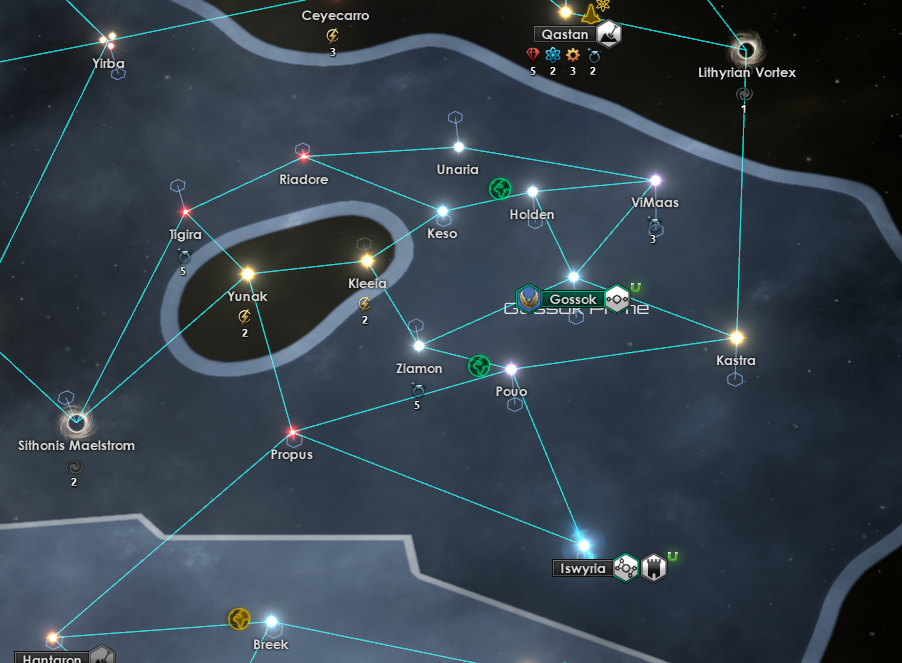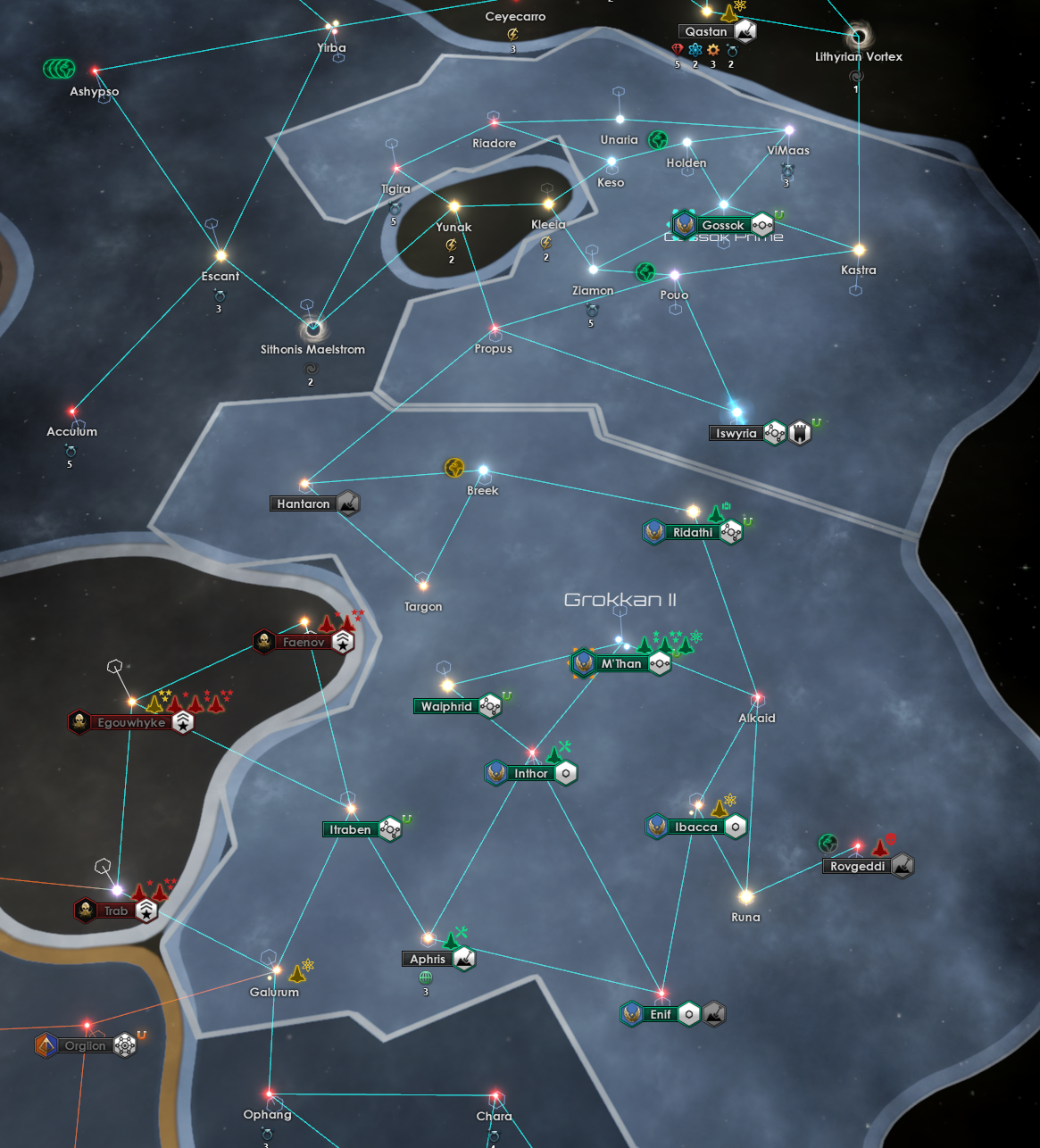Hello everyone!
First of all I want us to celebrate that today is the 3-year anniversary of Stellaris. Stellaris is such a great game that has changed a lot since its release. Since 1.0 we’ve added Civics, Traditions, Ascension Perks, Fallen Empires, Hive Minds, Machine Empires, planet killers, starbases and much much more.
When we started developing Stellaris, I don’t think we could ever foresee what Stellaris would become this many years later. It’s really become its own thing and it’s really fun to see how many new players – many of who may never have played any of our other games, or any other strategy game for that matter – have found their way to Stellaris. Stellaris is such a great game for telling your own stories and in general just enjoying the awesomeness of space.
A big thanks to our awesome community for making this game even better!
Alright, let’s move on to talking about sectors & designations. This will be a followup to Dev Diary #142 and I will try to outline what we’ve done so far.
Designations
Previously planets would automatically assume a role depending on what was built on it. It’s now possible to set this manually, if you wish to. Having played with this myself, I must say it feels pretty great to be able to make that choice directly yourself.

Automation
A new neat feature is that it’s now possible to decide which planets, regardless if they are in a sector or not, should be automated. Automated planets will build things according to a certain build order, which is set up per designation. For example:
If crime is high this will trigger a crisis that will build a Precinct House, ignoring the normal build order.
If a building in the build order can not be build, e.g. because you lack the technology, it will be skipped.
Automation will try to use its own Sector Stockpile if possible, otherwise it will use the Shared Stockpile. You can read more about the sector stockpiles further down in the dev diary.

Because we deemed the risk to be too high right now, AI empires will not manually set designations or use the build orders. Our goal is for that to be improved in later updates, however, and when it’s had more time in the cooker we will be deploying those changes.
Sectors
In the new system, sectors will be created by making a planet a Sector Capital. This will immediately form the sector and include all systems within 4 jumps of the Sector Capital. We originally had thought to make the range 6 jumps, but we feel like 4 jumps feels better.

It becomes very easy to create a new sector. Simply click the flag on the galaxy to open the planet view.

In the planet view we have a create sector button. Once clicked, it will immediately create the sector.

Boom! Sector created. It’s just as easy to delete the sector as it is to create a new one. The sector capital is also visible on the map with its own icon.
Sectors now also have a Shared Stockpile, in addition to their Local Stockpiles. It is possible to set monthly subsidies for your Shared Stockpile. This should make it a lot easier to manage larger empires.

What remains to do
We didn’t want to try to do too many things at once, so we will be going with the safer option of deploying these changes in increments. These changes will not be coming in the upcoming update, but rather in the future.
Left to do:
---
That is all we had to share for this week’s dev diary. I’m really looking forward to next week’s dev diary, when I’ll be sharing something awesome.
Thanks again to all of our community, and let’s look forward to the next 3 years!
First of all I want us to celebrate that today is the 3-year anniversary of Stellaris. Stellaris is such a great game that has changed a lot since its release. Since 1.0 we’ve added Civics, Traditions, Ascension Perks, Fallen Empires, Hive Minds, Machine Empires, planet killers, starbases and much much more.
When we started developing Stellaris, I don’t think we could ever foresee what Stellaris would become this many years later. It’s really become its own thing and it’s really fun to see how many new players – many of who may never have played any of our other games, or any other strategy game for that matter – have found their way to Stellaris. Stellaris is such a great game for telling your own stories and in general just enjoying the awesomeness of space.
A big thanks to our awesome community for making this game even better!
Alright, let’s move on to talking about sectors & designations. This will be a followup to Dev Diary #142 and I will try to outline what we’ve done so far.
Designations
Previously planets would automatically assume a role depending on what was built on it. It’s now possible to set this manually, if you wish to. Having played with this myself, I must say it feels pretty great to be able to make that choice directly yourself.

Automation
A new neat feature is that it’s now possible to decide which planets, regardless if they are in a sector or not, should be automated. Automated planets will build things according to a certain build order, which is set up per designation. For example:
- Build all district types of its designation
- Build the buildings following the build order of its designation
- Remove Blockers
- Repair Buildings
- Upgrade all buildings
If crime is high this will trigger a crisis that will build a Precinct House, ignoring the normal build order.
If a building in the build order can not be build, e.g. because you lack the technology, it will be skipped.
Automation will try to use its own Sector Stockpile if possible, otherwise it will use the Shared Stockpile. You can read more about the sector stockpiles further down in the dev diary.

Because we deemed the risk to be too high right now, AI empires will not manually set designations or use the build orders. Our goal is for that to be improved in later updates, however, and when it’s had more time in the cooker we will be deploying those changes.
Sectors
In the new system, sectors will be created by making a planet a Sector Capital. This will immediately form the sector and include all systems within 4 jumps of the Sector Capital. We originally had thought to make the range 6 jumps, but we feel like 4 jumps feels better.

It becomes very easy to create a new sector. Simply click the flag on the galaxy to open the planet view.

In the planet view we have a create sector button. Once clicked, it will immediately create the sector.

Boom! Sector created. It’s just as easy to delete the sector as it is to create a new one. The sector capital is also visible on the map with its own icon.

What remains to do
We didn’t want to try to do too many things at once, so we will be going with the safer option of deploying these changes in increments. These changes will not be coming in the upcoming update, but rather in the future.
Left to do:
- Have AI empires set manual designations
- Have AI empires use build orders for designations
- Allow players to have control over the build orders for the different designations
- Add nudging of systems between sectors
- Allow you to create new sectors from within a sector
- Display non-sector systems as a “Frontier Space” sector
- Rework Governor traits to be more widely applicable
- Look into automation for construction ships
---
That is all we had to share for this week’s dev diary. I’m really looking forward to next week’s dev diary, when I’ll be sharing something awesome.
Thanks again to all of our community, and let’s look forward to the next 3 years!

